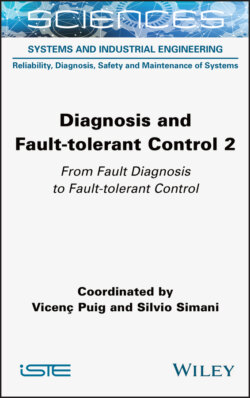Diagnosis and Fault-tolerant Control Volume 2

Реклама. ООО «ЛитРес», ИНН: 7719571260.
Оглавление
Группа авторов. Diagnosis and Fault-tolerant Control Volume 2
Table of Contents
Guide
List of Illustrations
List of Tables
Pages
Diagnosis and Fault-tolerant Control 2. From Fault Diagnosis to Fault-tolerant Control
1. Nonlinear Methods for Fault Diagnosis
1.1. Introduction
1.2. Fault diagnosis tasks
1.2.1. Residual generation task
1.2.2. Residual evaluation task
1.3. Model-based fault diagnosis
1.3.1. Parity space relations
1.3.2. Observer-based approaches
1.3.3. Nonlinear filtering methods
1.3.4. Nonlinear geometric approach strategy
1.4. Data-driven fault diagnosis
1.4.1. Online identification methods
1.4.2. Machine learning approaches to fault diagnosis
1.5. Model-based and data-driven integrated fault diagnosis
1.6. Robust fault diagnosis problem
1.7. Summary
1.8. References
2. Linear Parameter Varying Methods
2.1. Introduction
2.2. Preliminaries: a classical approach
2.3. Problem statement
2.4. Robust active fault-tolerant control design. 2.4.1. Robust observer-based FTC design
2.4.2. Stability analysis
2.5. Application: an anaerobic bioreactor
2.6. Conclusion
2.7. References
3. Fuzzy and Neural Network Approaches
3.1. Introduction
3.2. Fuzzy model design. 3.2.1. Takagi–Sugeno systems
3.2.2. Generation of TS models via nonlinear embedding
3.3. Neural model design. 3.3.1. Recurrent neural network
3.3.2. Identification of the neural model uncertainty
3.4. Fault estimation and diagnosis. 3.4.1. Actuator fault estimation using neural networks
3.4.2. Sensor and actuator fault estimation using fuzzy logic
3.5. Fault-tolerant control. 3.5.1. An overview of the fault-tolerant scheme
3.5.2. Robust fault estimation and control
3.5.3. Derivation of a robust invariant set
3.5.4. Efficient predictive FTC
3.6. Illustrative examples. 3.6.1. Sensor and actuator fault estimation example
3.6.2. Fault-tolerant control example
3.7. Conclusion
3.8. Acknowledgment
3.9. References
4. Model Predictive Control Methods
4.1. Introduction
4.2. Idea of MPC
4.3. Robustness of MPC
4.4. Neural-network-based robust MPC
4.4.1. Neural network models
4.4.2. Nonlinear MPC
4.4.3. Approximate MPC
4.4.4. Robust nonlinear MPC
4.4.5. Robust approximate MPC
4.5. Robust control of a pneumatic servo
4.5.1. Robust nonlinear neural-network-based MPC
4.5.2. Robust approximate neural-network-based MPC
4.6. Conclusion
4.7. References
5. Nonlinear Modeling for Fault-tolerant Control
5.1. Introduction
5.1.1. Joint fault diagnosis and control
5.1.2. Nonlinear adaptive fault estimators
5.1.3. Fuzzy fault-tolerant control
5.1.4. Recursive adaptive control
5.1.5. Sustainable control
5.2. Fault-tolerant control strategies
5.2.1. Fault tolerance and compensation
5.3. Fault diagnosis and tolerant control
5.3.1. Fault-tolerant control design
5.4. Summary
5.5. References
6. Virtual Sensors and Actuators
6.1. Introduction
6.2. Problem statement
6.3. Virtual sensors and virtual actuators
6.4. LMI-based design
6.5. Additional considerations
6.6. Application example
6.6.1. Virtual actuator
6.6.2. Virtual sensors
6.7. Conclusion
6.8. References
7. Conclusions
7.1. Introduction
7.2. Closing remarks
7.3. References
8. Open Research Issues
8.1. Further works and open problems
8.1.1. Sustainable control design objectives
8.1.2. Sustainable control concepts and approaches
8.1.3. Sustainable control approaches and working methods
8.1.4. Sustainable control design ambition
8.1.5. Sustainable control innovation potentials
8.1.6. Sustainable control expected impacts
8.2. Summary
8.3. References
List of Authors
Index
A
B, C
D, E
F
G, H
I, K
L, M
N
O, P
R
S
T, U
V, Z
Summary of Volume 1
WILEY END USER LICENSE AGREEMENT
Отрывок из книги
Systems and Industrial Engineering, Field Director – Jean-Paul Bourrières
.....
Coordinated by
Vicenç Puig
.....